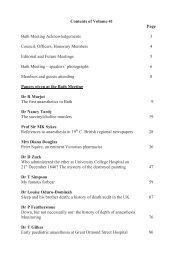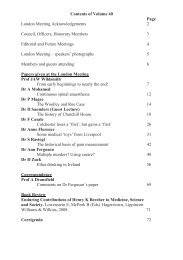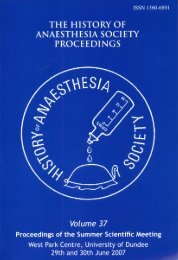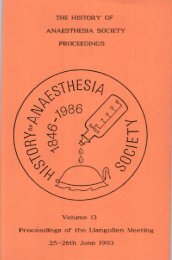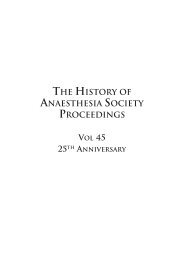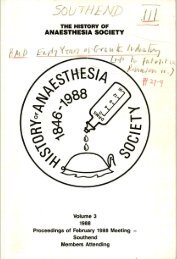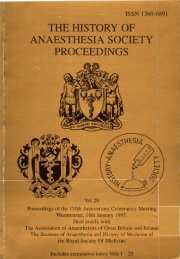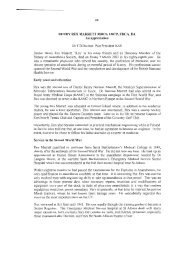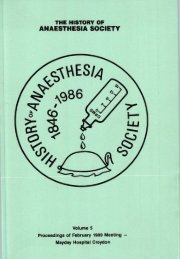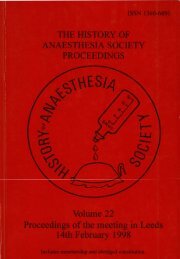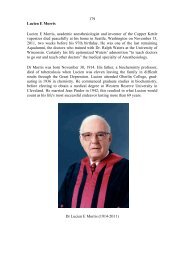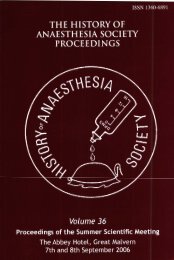Volume 7 - History of Anaesthesia Society
Volume 7 - History of Anaesthesia Society
Volume 7 - History of Anaesthesia Society
You also want an ePaper? Increase the reach of your titles
YUMPU automatically turns print PDFs into web optimized ePapers that Google loves.
On Friday August 27 1858, a young wanan presented herself at the house<br />
oE an Egsom druggist, one i.lr Keeling, who also maintainep an extensive<br />
dental practice in Surrey and the neighbouring counties. She desired<br />
to have a tooth extracted under the influence <strong>of</strong> chlor<strong>of</strong>orm.<br />
'The woman, descril d throughout as 'a remarkably tall, Eine young woinan<br />
<strong>of</strong> two-and-t~ent~',~ was the servant <strong>of</strong> Dr Samuel Barrett, a physician<br />
<strong>of</strong> the neighbouring parish <strong>of</strong> Ewell. She had lived in the household for<br />
some seven years, and during that tiine had become a cherished companion<br />
to ii*r mistress and the children. She had witnessed the successful<br />
removal <strong>of</strong> teeth under chlor<strong>of</strong>orm administered by Mr Keeling, not only<br />
from her mistress buf also the two little boys aged 10 and 12. Now,<br />
suffering from toothache herself, she wished to have the same treatment.<br />
Dr Barrett, secure in the knowledge that she was in good health, gave<br />
his written authocity.<br />
Armed with this paper, and accompanied by Yrs Barrett, she walked to<br />
Epsom. Yr Keeling administered chlor<strong>of</strong>orm, 'merely to deaden tE<br />
nervous sensibiLity oE his patient - not to produce unconsciousness .<br />
She was given chloroEorm on a napkin to inhale, and when she said 'now'<br />
thc tooth was extracted almost instantaneously. She appeared to faint,<br />
and &spite vigorous and prolonged attempts at resuscitation, could not<br />
be revived.<br />
Mr Keeling promptly despatched messengers into the town, to seek medical<br />
assistance. Dr Barrett was, coincidentally, on his way to Epsoin, and<br />
was met by one. fle hurried to the scene, but could do no more than to<br />
pronounce the unfortunate victim dead. Mrs Rarrett wa deeply<br />
distressed, but 'Mr Keeling's nerve never once forsook hi,nl' and he<br />
conducted himself admirably throughout.<br />
The inquest, with jury, was held on the following day, Saturday August<br />
28, 1853. he verdict was 'Accidental Death'. Mr Keelig was<br />
'acquitted oE the slightest blame', but the jury desired to recomnend<br />
the cautious use <strong>of</strong> chlor<strong>of</strong>orm in triELing operations in future. On<br />
this subject, Mr Keeling himself expressed the opinion that death had<br />
been caused by the administration <strong>of</strong> a minimum quantity <strong>of</strong> chlor<strong>of</strong>orm,<br />
and he wished to emphasise thereEore that this mink quantity,<br />
administered with the greatest caution, may yet prove Fatal. He<br />
concurred entirely with the view oE the jury about the future use <strong>of</strong><br />
chlor<strong>of</strong>orm in operations <strong>of</strong> a minor character.<br />
The Full story appeared in the 'Times' <strong>of</strong> Monday August 30, 1858, and<br />
was followed by a vigorous correspndence. A letter appearing th<br />
following day gave the writer's idiosyncratic views on resuscitation, 9<br />
and someone signing hinself 'M.R.C.S.' wrote to ment on the<br />
appropri te use oE chl~r<strong>of</strong>orm.~ This last excited the derision <strong>of</strong> the<br />
'Lamet" which was much involved in the chlomform debate. Although<br />
its opinions were, <strong>of</strong> course, anonymous, they bear the characteristic



